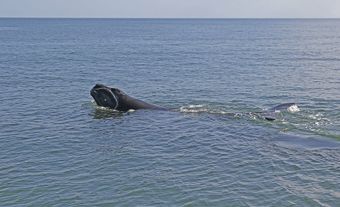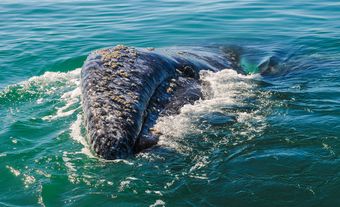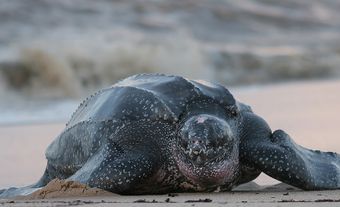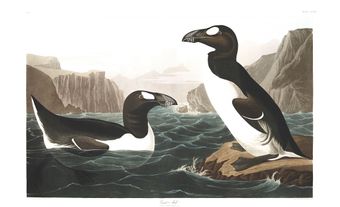Basking sharks (Cetorhinus maximus) are large, migratory sharks found in temperate oceans around the world. Basking sharks seasonally inhabit both the Atlantic and Pacific coasts of Canada. An estimated 10,000 sharks make up the Atlantic population; however, they are rarely seen in Canada’s Pacific Ocean. The Canadian Species at Risk Act lists the Pacific population as endangered. By comparison, the Committee on the Status of Endangered Animals in Canada considers the Atlantic population “special concern.” (See also Endangered Animals in Canada.)

Physical Description
The basking shark is the largest fish found in Canadian waters, reaching up to 12 m in length and weighing up to 4 tonnes. Globally, their size is only surpassed by the whale shark. Basking sharks are dark black to brownish grey, often with a dappled colour pattern. Their large, cone-shaped snouts are flanked by five pairs of elongated gills, which span from the tops of their heads to their throats. Each gill slit is densely lined with thin, comb-like bristles called gill rakers. Their extremely large mouths contain about 1,500 hook-shaped teeth, each about half a centimetre in length.
Distribution and Habitat
Basking sharks are mainly found in the temperate regions of the Atlantic and Pacific oceans, and some parts of the Indian Ocean near southern Australia, Indonesia and South Africa. Basking sharks migrate with prey abundance. They feed and mate along the Canadian Atlantic coastline during the spring and summer when the waters are teeming with zooplankton, the sharks’ primary prey. Although they are most often sighted in shallow coastal waters, basking sharks are proficient divers. They have been recorded offshore at depths of over 1 km below the surface. Little is known about their migration routes, but scientists once tracked a tagged female shark travelling across the Atlantic from the British Isles to Newfoundland — a total distance of 9,589 km.
Reproduction
Scientists know little about the basking shark life cycle, but they are estimated to live for up to 50 years. Males reach sexual maturity at 12 to 16 years of age, and females between the ages of 16 and 20. After an estimated 2–3.5 year gestation females give birth to live young. Newborn pups are 1.5–2 m in length and instinctively swim towards the surface to feed.

Behaviour
Basking sharks were named for their tendency to coast slowly at the ocean’s surface, which 18th century naturalists interpreted as the animals “basking” in the sun. In reality, this is how basking sharks forage.
As they swim forwards, seawater continuously flows into the sharks’ open mouths and through their gills. Small prey including zooplankton and fish eggs are trapped in the gill rakers in a process called “filter-feeding.” There are only two other filter-feeding shark species, the rare megamouth shark and the whale shark. Despite their impressive size, these sharks’ diet of plankton means that they pose no danger to humans.
Basking sharks do not use their many rows of teeth during feeding. Instead, scientists believe that males chase and bite females during mating. Mating sharks will gather in groups of up to 50 individuals, with males circling and closely following females for several hours. During social interactions, basking sharks will also launch their entire bodies out of the water, a behaviour known as breaching. Scientists speculate that large male sharks breach to compete for the attention of a female, while mature female sharks may breach to signal receptiveness to mating.
Relationship to Humans
Nineteenth century reports suggest that the Nuu-chah-nulth and Huu-ay-aht peoples once hunted basking sharks off Vancouver Island. Unlike marine mammals such as seals, basking sharks are easy to approach and slow to flee, making them easy targets for harpooning. At the time, basking sharks were highly abundant along the Canadian west coast. They were mainly hunted for their large volumes of liver oil. A stream in Clayoquot Sound is known as “shark creek” after the Nuu-chah-nulth word for basking shark, mamach-aqtlnit.
The basking shark fishery was a lucrative industry in the northeast Atlantic around Scotland, Ireland and Norway. Here, basking sharks were likewise targeted for their oil-rich livers and were heavily fished from the 18th to 20th centuries.
By the 1950s, fishing fleets in British Columbia considered basking sharks to be a nuisance because they would get caught in and destroy salmon nets. These complaints prompted the Department of Fisheries and Oceans to conduct an eradication program, which involved ramming the animals with a large blade placed at the front of a vessel.
The combination of commercial exploitation, bycatch (incidental catches during fishing for other species) and eradication programs severely reduced basking shark numbers. Today, the Canadian Pacific population is thought to have declined by over 90 percent compared to historical figures.

Threats and Conservation
Although harvesting this species is prohibited in many countries today, there remains an active illegal market for basking shark products. Fins alone are worth up to $57,000 and are traded in Hong Kong, Japan and the United States. Basking sharks remain vulnerable to entanglements in fishing gear, ship strikes, disturbance from tour boats, as well as habitat destruction from coastal developments due to their tendency to feed and socialize near coasts.
A major challenge for conservation is how little is known about the species’ life history and illicit trade. For example, estimating basking shark abundance is complex because population counts can only be done at the surface, and the number of individuals surfacing will depend on the density of nutrients available at a given time and location. Scientists are working to fill these knowledge gaps and use tools such as satellite tags to better understand migration patterns, how sharks use deepwater habitats, where they spend the winter months, and what makes up critical nursery habitat. To trace and combat poaching, DNA forensics methods have been developed to help confirm the trade of basking shark products. Since the animals are sold in parts, it can be impossible to visually identify basking shark products on the market. These laboratory tests identify species by matching DNA sequences (genetic code) from small tissue samples to known sequences unique to basking sharks.

 Share on Facebook
Share on Facebook Share on X
Share on X Share by Email
Share by Email Share on Google Classroom
Share on Google Classroom



